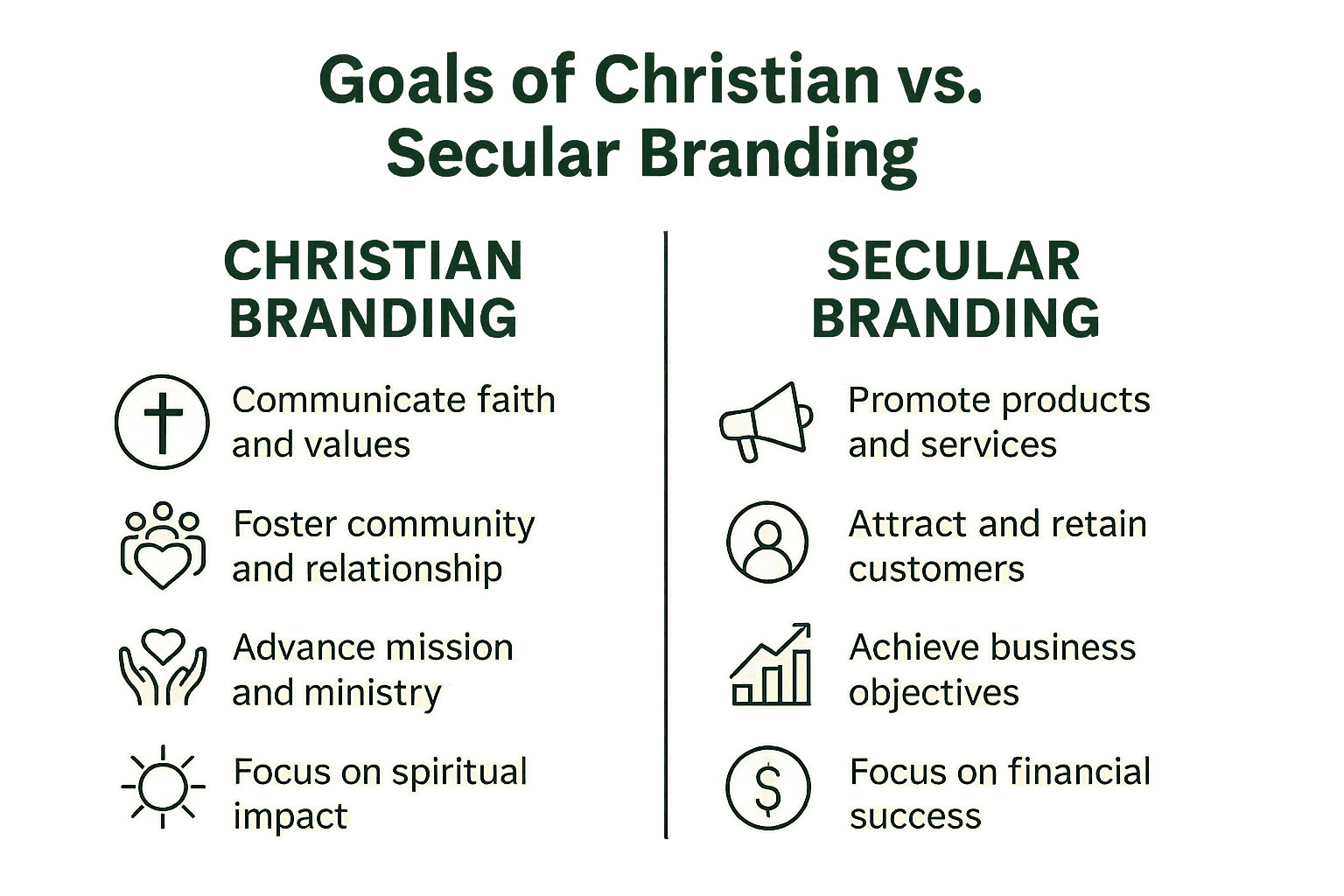Introduction: Understanding Christian Branding in the Modern Era
Many of us think of branding as something only for businesses. But churches, ministries, and Christian organizations also need a clear identity. For them, branding goes beyond just marketing.
It’s about clearly showing who they are and what they stand for. A strong brand helps them connect with their community. It also makes their message clear and easy to understand. This is vital for effective outreach and reaching new generations.
In this comprehensive guide, we will explore Christian branding in depth. We will define what it means and why it holds such importance. We will also look at its core elements and how it differs from secular branding.
Our goal is to help churches and ministries develop an authentic identity. We will cover how to build a consistent brand, leverage digital platforms, and tell powerful stories. We will also discuss ethical considerations and common pitfalls to avoid.
Understanding a robust Christian branding strategy is key to making a lasting impact in the modern era.
Christian branding, at its heart, is the intentional cultivation of a distinct identity and reputation for a church, ministry, or Christian organization. It’s about how they are perceived by their community and beyond. Unlike commercial branding, which primarily aims to sell products or services, Christian branding seeks to effectively communicate a mission, values, and the transformative message of faith. It’s about inviting people into a community and a relationship, not just making a transaction.
The importance of Christian branding for churches and ministries cannot be overstated in today’s increasingly complex and noisy world. With an estimated 2.4 billion Christians globally, there’s a vast audience seeking faith-based content and communities. However, connecting with this audience, and indeed with those new to faith, requires clarity and resonance. A strong brand helps a church or ministry stand out, making it easier for people to understand what they offer, what they believe, and how they can belong. It fosters trust and recognition, essential for building lasting relationships.
Branding helps a church or ministry connect with its target audience and communicate its mission effectively by creating a consistent and compelling narrative. It answers the fundamental question: “Who are we, and why do we exist?” This clarity is crucial for attracting new members, engaging existing ones, and mobilizing volunteers. When a church’s brand is clear, it simplifies the process of inviting others, making word-of-mouth invitations more effective. This directly relates to its evangelistic outreach, as a well-defined brand makes the church’s message more accessible and appealing to those it seeks to reach.
Christian Branding vs. Secular Branding
How does Christian branding differ from secular branding? While both use similar tools—logos, messaging, visual identity—their underlying motivations and ethical frameworks diverge significantly. Secular branding is typically profit-driven, focused on market share, competitive advantage, and consumer loyalty to a product or service. Its success is often measured by sales figures and financial returns.
Christian branding, conversely, is purpose-driven and mission-centric. Its ultimate goal is not financial gain but spiritual impact, community change, and the advancement of the Gospel. Success is measured by engagement, spiritual growth, service to others, and the fulfillment of its divine calling. This distinction means that authenticity and integrity are paramount in Christian branding, as any perceived commercialization of faith can undermine its core message. It prioritizes serving a mission over maximizing profit.

Churches and Christian organizations that invest in professional branding often report increased engagement and community connection. This isn’t just about looking good; it’s about being understood and trusted. As online platforms become increasingly important for churches to reach new members and communicate their message, digital branding becomes crucial. A strong brand identity helps Christian organizations differentiate themselves and clearly communicate their unique mission and values in a crowded digital landscape.
The Core Pillars of an Authentic Christian Brand
Effective Christian branding is built upon several foundational elements that work together to create a cohesive and impactful identity. These core elements ensure that the brand is authentic, consistent, and deeply reflective of the organization’s faith and purpose.
Mission and Vision Statements
These are the bedrock of any Christian brand. A mission statement defines the organization’s purpose, its reason for existence, and what it does. It’s the “what” and “why.” A vision statement articulates the desired future state, where the organization is headed, and the impact it hopes to make. It’s the “where are we going?” Together, they provide guiding principles and foundational messaging for all branding efforts. For instance, a mission might be “to make disciples of Jesus Christ,” while a vision could be “to see our city transformed by the love of God.” These statements clarify the organization’s unique calling, allowing it to “be known for something” distinct and meaningful. Resources like “Branding 101 for Churches and Ministries” emphasize the importance of these statements in communicating identity and value.
Core Values
Core values are the biblical foundations and guiding principles that dictate behavior, decision-making, and communication within the organization. They are the non-negotiables that shape the culture and ensure authenticity. Examples might include “love,” “service,” “integrity,” “community,” or “discipleship.” These values build trust with the audience, demonstrating that the brand lives what it preaches.
Visual Identity
This is what people see and recognize. It includes:
- Logo Design: A well-designed logo is often the most recognizable element of a brand. It should be simple, memorable, versatile, and appropriate for the organization’s mission. It visually encapsulates the essence of the brand.
- Color Psychology: Colors evoke emotions and associations. Choosing a consistent color palette that aligns with the brand’s values (e.g., warm colors for welcome, cool colors for peace) is crucial.
- Typography: The choice of fonts contributes significantly to the brand’s personality, conveying anything from traditional reverence to modern accessibility.
A cohesive visual identity ensures that everything from the website to print materials presents a unified and professional image. For insights into creating compelling visual elements, the Church Brand Guide offers valuable resources on logo and website design.
Storytelling
Storytelling is a powerful tool in Christian branding. It involves sharing narratives of faith, change, and impact. This includes personal testimonies, historical accounts of the organization, and stories of how the community is making a difference. Storytelling connects emotionally with the audience, making the brand relatable and inspiring. It communicates the “why” behind the mission in a compelling way, demonstrating the brand’s authenticity and impact. As the article “Christianity: The greatest brand ever built” suggests, powerful narratives have always been central to the Christian faith.
The Significance of Symbols in Christian Branding
Symbols play a profound role in Christian branding, acting as shorthand for deep theological truths and historical connections. They are visual anchors that can instantly communicate identity and belief.
- Traditional Symbols:
- The Cross: Universally recognized, the cross symbolizes Christ’s sacrifice, resurrection, and the core of Christian faith. Its simplicity and power make it a timeless and potent brand element.
- The Ichthys (Fish): An ancient symbol used by early Christians as a secret sign, the Ichthys represents “Jesus Christ, God’s Son, Savior.” Its historical significance adds a layer of depth and connection to early Christian heritage.
- The Dove: Often symbolizing the Holy Spirit, peace, and new beginnings (as in Noah’s Ark or Christ’s baptism), the dove conveys serenity and divine presence.
- Modern Interpretations: While traditional symbols remain powerful, modern Christian branding often reinterprets them or uses abstract designs that subtly hint at Christian themes without being overtly literal. This can make a brand more accessible to a broader audience while retaining its spiritual essence.
- Using Symbols Effectively: The key is to use symbols thoughtfully, ensuring they align with the organization’s specific mission and values. They should improve the brand’s message, not overshadow it. Avoiding clichés and ensuring relevance to the target audience are important considerations. A well-chosen symbol can create immediate recognition and convey profound meaning. For inspiration on how symbols are incorporated into design, exploring a Wonderful Collection of Christian Logos can be highly beneficial.

Crafting Your Message and Voice
Beyond visuals, how a Christian brand speaks is just as important as what it looks like.
- Brand Voice: This is the consistent personality and emotion expressed in all communications. Is it welcoming, authoritative, compassionate, joyful, or contemplative? The voice should reflect the core values and mission.
- Tone: While voice is consistent, tone can adapt to different situations. For instance, a church’s social media tone might be more casual and conversational than its sermon notes, but both should reflect the overarching brand voice.
- Consistency Across Platforms: Whether it’s a sermon, a website, a social media post, or a newsletter, the messaging must be consistent. This builds trust and reinforces the brand identity.
- Language that Resonates: The language used should be clear, authentic, and custom to the target audience. It should avoid jargon where possible and speak to the hearts and minds of those it seeks to reach. Effective Content Promotion relies heavily on a consistent and resonant brand voice.
Developing and Implementing Your Brand Strategy
Developing and implementing a consistent and authentic brand identity for churches and ministries requires a strategic approach that integrates internal values with external communication.
Audience Research
Understanding who you are trying to reach is paramount. This involves more than just demographics; it digs into psychographics—the attitudes, aspirations, and challenges of your target audience. Conducting surveys, focus groups, and analyzing community data can reveal crucial insights into their needs and how the church can best serve them. Tailoring your message to resonate with these specific audiences ensures that your branding efforts are not just aesthetically pleasing but deeply impactful.
Building Consistency
Consistency is the hallmark of a strong brand. A Brand Awareness campaign thrives on uniformity. This means developing a comprehensive brand style guide that outlines everything from logo usage and color palettes to typography, imagery, and brand voice. This guide ensures that all communications—whether internal or external, digital or print—present a unified front. Unifying ministry teams around this guide ensures that everyone is on the same page, delivering a consistent experience online and offline. This consistency builds trust and reinforces the brand’s identity over time.
Digital Presence
In the modern era, a robust digital presence is non-negotiable for churches and ministries seeking to leverage branding effectively.
- Church Websites: A church’s website serves as its digital front door. It should be welcoming, easy to steer, and clearly communicate the brand’s identity, mission, and values. Professional Church Websites are crucial for first impressions.
- SEO for Findability: Optimizing the website and content for search engines (SEO) ensures that people looking for a church or specific faith-based resources can find your organization. SEO for Churches helps increase visibility.
- Content Strategy: Regularly creating valuable content—sermon archives, blog posts, devotionals, event information—reinforces the brand’s message and engages the audience.
- Social Media Marketing: Active and strategic engagement on platforms relevant to your audience is vital. Social Media Marketing for Churches allows for direct interaction, sharing stories, and building community.
- Online Presence Management: Consistently managing reviews, listings, and online mentions across various platforms contributes to a positive brand reputation. Comprehensive Online Presence Management ensures all digital touchpoints align with the brand.
These elements fall under broader Digital Marketing Services and Marketing and Advertising strategies, which are essential for outreach. For example, staying abreast of Top Branding Trends of 2025 can inform digital strategy, emphasizing hyper-personalization and community building.
Physical Environment
A church’s physical space and community interactions significantly contribute to its brand identity.
- Welcoming Spaces: The physical environment—from the parking lot to the sanctuary—should reflect the brand’s values. Is it clean, inviting, and accessible? Does it convey warmth, reverence, or community?
- Signage: Clear and consistent signage helps visitors steer and reinforces the brand visually.
- Interior Design: The aesthetics of the building, including colors, furniture, and art, should align with the overall brand message. For instance, a church emphasizing modern relevance might have a contemporary design, while one focused on tradition might accept classical elements.
These elements create an immersive brand experience that extends beyond digital interactions.
Measuring Effectiveness
How can churches measure the effectiveness of their branding efforts?
- Church Growth Metrics: Tracking attendance, membership, and new visitor numbers can indicate brand reach.
- Community Engagement: Measuring participation in programs, volunteer rates, and feedback from surveys can gauge how well the brand is fostering connection.
- Online Analytics: Website traffic, social media engagement rates (likes, shares, comments), and conversion rates (e.g., sign-ups for events) provide quantitative data on digital brand performance.
- Feedback and Surveys: Qualitative feedback from congregants and the wider community offers insights into brand perception and areas for improvement.
- Case Studies: Analyzing the success of specific initiatives, much like the missional branding case study of the Church of Pentecost, can provide valuable lessons.
By consistently monitoring these metrics, churches can refine their branding strategies, ensuring they remain authentic, relevant, and effective in fulfilling their mission. Implementing a strong Website Design Services and Search Engine Marketing strategy can significantly aid in tracking and improving these metrics.
Christian branding, while powerful, comes with unique ethical considerations and potential pitfalls. The very nature of faith-based organizations demands a higher level of integrity and authenticity to avoid misrepresenting their mission or compromising biblical principles.

Common Pitfalls
- Being Inauthentic: One of the most significant dangers is creating a brand that doesn’t genuinely reflect the church’s or ministry’s true character, values, or practices. A disconnect between the brand’s promise and its reality can lead to cynicism and mistrust.
- Overly Corporate Feel: While professionalism is good, an overly slick or corporate brand can alienate people who expect genuine community and spiritual depth. It can inadvertently commercialize faith, making it seem like a product to be consumed rather than a relationship to be entered.
- Neglecting the Core Mission: Branding should serve the mission, not become the mission itself. If the focus shifts from spiritual change and community service to merely “looking good” or attracting numbers, the brand has lost its way.
- Inconsistent Application: A brand that is not consistently applied across all touchpoints—from the pulpit to social media, from internal communication to external outreach—will appear disjointed and unprofessional, undermining its credibility.
- Commercialization of Faith: This is a critical ethical consideration. Christian branding must avoid the perception that faith is being “sold” or exploited for financial gain. The message should always be one of invitation, service, and spiritual truth, not a sales pitch. As discussed in “Branding and the Reputation of Jesus Christ,” the goal is to make Christ known, not to make the gospel marketable.
Personal Branding for Leaders
For Christian leaders and athletes, personal branding presents a unique set of challenges and opportunities.
- Aligning with Biblical Principles: The concept of personal branding, which often involves self-promotion, can seem at odds with biblical principles of humility and servant leadership. The Bible consistently warns against pride and self-exaltation (Proverbs 27:2).
- Humility vs. Self-Promotion: How does one build a platform for influence without falling into self-aggrandizement? The answer lies in shifting the focus from self to service. A Christian leader’s personal brand should be about leveraging their gifts and platform to glorify God, serve others, and advance the Kingdom, rather than accumulating personal fame or wealth.
- Servant Leadership: Jesus himself modeled servant leadership, putting others’ needs before His own. A Christian leader’s personal brand should reflect this ethos, emphasizing their role as a steward of their influence for the benefit of others.
- Using Influence for Service: Whether an athlete, pastor, or entrepreneur, the goal is to use one’s platform to share the Gospel, advocate for justice, inspire faith, and build community. This aligns with the principles explored in “Personal Branding and the Bible,” which digs into the spiritual impact of branding and the virtue of humility. For practical guidance on this, resources like “7 Steps to Launching Your Christian Personal Brand” can offer insights into building a faith-aligned personal brand.
Ethical Considerations in Christian Branding
Beyond the pitfalls, deeper ethical considerations guide authentic Christian branding.
- Authenticity and Transparency: The brand must be genuinely transparent about its beliefs, practices, and intentions. There should be no hidden agendas or deceptive messaging. Integrity is paramount, reflecting the character of Christ.
- Integrity in Messaging: All communications should be truthful, accurate, and consistent with biblical teachings. This avoids misrepresentation or diluting the Gospel message for broader appeal.
- Avoiding Commercialization of Faith: This is perhaps the most sensitive area. Churches and ministries are not businesses in the secular sense. Their “product” is salvation, community, and spiritual growth, which cannot be commodified. Branding efforts should always reinforce this sacred nature, emphasizing giving, service, and spiritual change over material gain. This means carefully considering how events are promoted, how donations are solicited, and how the overall image is presented to ensure it never cheapens the message of faith.
Frequently Asked Questions about Christian Branding
How can a small church with a limited budget start branding?
Even with limited resources, a small church can initiate effective branding. The key is to focus on clarity and intentionality.
- Focus on Clarity: Begin by clearly defining your church’s mission, vision, and core values. What makes your church unique? What is its primary purpose? This foundational work costs nothing but time and prayer.
- Start with Mission/Vision: Once these are clear, ensure they are communicated consistently in sermons, announcements, and any written materials. This forms the backbone of your brand message.
- Use Free Design Tools: Leverage free or low-cost online design tools (like Canva) to create simple, clean logos and visual elements. Consistency in font choices and a limited color palette can create a professional look without professional design fees.
- Prioritize a Welcoming Online Presence: A basic, mobile-friendly Church Website is essential. Many platforms offer affordable templates. Ensure your Google My Business profile is updated.
- Empower Volunteers: Enlist creative volunteers from your congregation who have design, writing, or social media skills. Provide them with clear guidelines based on your defined brand.
Is it wrong to “market” the church?
This is a common concern within Christian circles. The perception of “marketing” can carry negative connotations, often associated with commercialism or manipulation. However, there’s a crucial distinction to be made:
- Distinction between Marketing and Evangelism: True Christian branding and “marketing” are not about selling faith, but about effective communication and invitation. Evangelism is the act of sharing the Gospel; branding is the means by which the church makes itself known, understood, and accessible to facilitate that sharing.
- Stewardship of Message: Viewing branding as stewardship means carefully and responsibly managing how the church’s message is presented. It’s about clarity, authenticity, and removing barriers to understanding.
- Invitation vs. Sales Pitch: The goal is always an invitation to relationship with God and community, not a sales pitch. A well-branded church simply makes it easier for people to hear and respond to that invitation.
- Making the Church Accessible: In a world saturated with information, effective branding helps the church cut through the noise, ensuring its message reaches those who need it most. As a Christian Creative Home might suggest, creative work can serve the mission.
How often should a church or ministry rebrand?
Rebranding is a significant undertaking and shouldn’t be done lightly or frequently.
- Rebranding vs. Brand Refresh: Often, what’s needed is a “brand refresh” rather than a full “rebrand.” A refresh involves minor updates to visual elements or messaging to keep the brand looking current without changing its core identity.
- When Mission Shifts: A full rebrand might be necessary if the church’s core mission or vision genuinely shifts, perhaps due to a significant change in leadership, theological direction, or target community. The brand must reflect this new reality.
- When the Brand Feels Outdated: If the current brand identity feels significantly outdated, unprofessional, or no longer resonates with the community it serves (or wishes to serve), a rebrand can revitalize perception.
- When Connecting with a New Audience: If the church is intentionally trying to reach a new demographic or geographic area, a rebrand might be considered to better appeal to that specific audience, ensuring the brand speaks their language and addresses their needs.
Generally, a well-conceived brand should have longevity. Regular assessments of brand effectiveness and occasional refreshes are more common than complete overhauls.
Conclusion
In conclusion, Christian branding is far more than just a logo or a catchy slogan. It is a holistic and intentional approach to defining and communicating the unique identity, mission, and values of a church, ministry, or Christian organization. It’s about reputation, authenticity, and connection.
We’ve explored how Christian branding differs fundamentally from its secular counterpart, driven by purpose and mission rather than profit. We’ve digd into the core elements—mission, vision, values, visual identity, and storytelling—that form the bedrock of an authentic Christian brand. The significance of symbols, the power of a consistent voice, and the strategic implementation across physical and digital spaces are all crucial components.
Branding in the Christian context is a form of stewardship. It is our responsibility to effectively communicate the life-changing message of the Gospel and to make our communities welcoming and accessible. By building an authentic, mission-focused brand, churches and ministries can connect deeply with their target audience, clearly communicate their purpose, and extend their evangelistic outreach in meaningful ways. This strategic approach ensures that the vital work of faith continues to thrive and transform lives in the modern world.
To learn more about how to strengthen your church’s outreach and digital presence, visit our comprehensive guide on Church Marketing.
